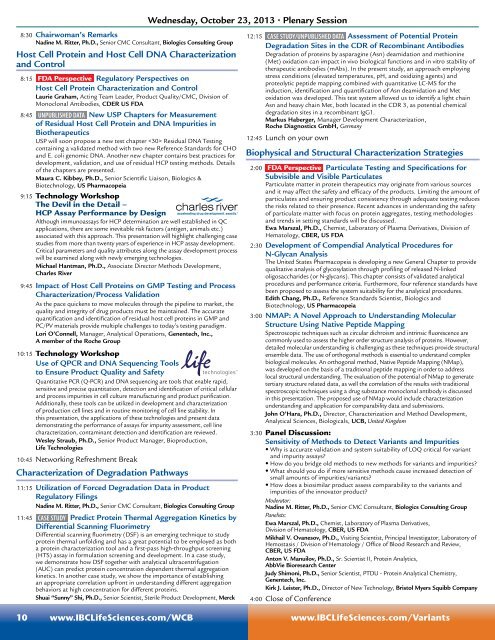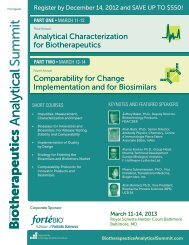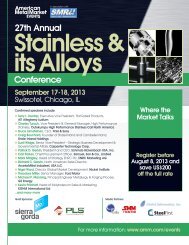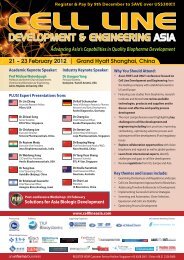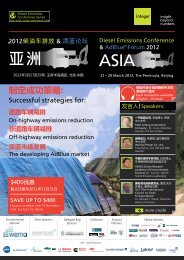Product and Process Variants & Impurities
Product and Process Variants & Impurities
Product and Process Variants & Impurities
- No tags were found...
Create successful ePaper yourself
Turn your PDF publications into a flip-book with our unique Google optimized e-Paper software.
Wednesday, October 23, 2013 • Plenary Session8:30 Chairwoman’s RemarksNadine M. Ritter, Ph.D., Senior CMC Consultant, Biologics Consulting GroupHost Cell Protein <strong>and</strong> Host Cell DNA Characterization<strong>and</strong> Control8:15 FDA Perspective Regulatory Perspectives onHost Cell Protein Characterization <strong>and</strong> ControlLaurie Graham, Acting Team Leader, <strong>Product</strong> Quality/CMC, Division ofMonoclonal Antibodies, CDER US FDA8:45 UNPUBLISHED DATA New USP Chapters for Measurementof Residual Host Cell Protein <strong>and</strong> DNA <strong>Impurities</strong> inBiotherapeuticsUSP will soon propose a new test chapter Residual DNA Testingcontaining a validated method with two new Reference St<strong>and</strong>ards for CHO<strong>and</strong> E. coli genomic DNA. Another new chapter contains best practices fordevelopment, validation, <strong>and</strong> use of residual HCP testing methods. Detailsof the chapters are presented.Maura C. Kibbey, Ph.D., Senior Scientific Liaison, Biologics &Biotechnology, US Pharmacopeia9:15 Technology WorkshopThe Devil in the Detail –HCP Assay Performance by DesignAlthough immunoassays for HCP determination are well established in QCapplications, there are some inevitable risk factors (antigen, animals etc.)associated with this approach. This presentation will highlight challenging casestudies from more than twenty years of experience in HCP assay development.Critical parameters <strong>and</strong> quality attributes along the assay development processwill be examined along with newly emerging technologies.Michael Hantman, Ph.D., Associate Director Methods Development,Charles River9:45 Impact of Host Cell Proteins on GMP Testing <strong>and</strong> <strong>Process</strong>Characterization/<strong>Process</strong> ValidationAs the pace quickens to move molecules through the pipeline to market, thequality <strong>and</strong> integrity of drug products must be maintained. The accuratequantification <strong>and</strong> identification of residual host cell proteins in GMP <strong>and</strong>PC/PV materials provide multiple challenges to today’s testing paradigm.Lori O’Connell, Manager, Analytical Operations, Genentech, Inc.,A member of the Roche Group10:15 Technology WorkshopUse of QPCR <strong>and</strong> DNA Sequencing Toolsto Ensure <strong>Product</strong> Quality <strong>and</strong> SafetyQuantitative PCR (Q-PCR) <strong>and</strong> DNA sequencing are tools that enable rapid,sensitive <strong>and</strong> precise quantitation, detection <strong>and</strong> identification of critical cellular<strong>and</strong> process impurities in cell culture manufacturing <strong>and</strong> product purification.Additionally, these tools can be utilized in development <strong>and</strong> characterizationof production cell lines <strong>and</strong> in routine monitoring of cell line stability. Inthis presentation, the applications of these technologies <strong>and</strong> present datademonstrating the performance of assays for impurity assessment, cell linecharacterization, contaminant detection <strong>and</strong> identification are reviewed.Wesley Straub, Ph.D., Senior <strong>Product</strong> Manager, Bioproduction,Life Technologies10:45 Networking Refreshment BreakCharacterization of Degradation Pathways11:15 Utilization of Forced Degradation Data in <strong>Product</strong>Regulatory FilingsNadine M. Ritter, Ph.D., Senior CMC Consultant, Biologics Consulting Group11:45 CASE STUDY Predict Protein Thermal Aggregation Kinetics byDifferential Scanning FluorimetryDifferential scanning fluorimetry (DSF) is an emerging technique to studyprotein thermal unfolding <strong>and</strong> has a great potential to be employed as botha protein characterization tool <strong>and</strong> a first-pass high-throughput screening(HTS) assay in formulation screening <strong>and</strong> development. In a case study,we demonstrate how DSF together with analytical ultracentrifugation(AUC) can predict protein concentration dependent thermal aggregationkinetics. In another case study, we show the importance of establishingan appropriate correlation upfront in underst<strong>and</strong>ing different aggregationbehaviors at high concentration for different proteins.Shuai “Sunny” Shi, Ph.D., Senior Scientist, Sterile <strong>Product</strong> Development, Merck12:15 CASE STUDY/UNPUBLISHED DATA Assessment of Potential ProteinDegradation Sites in the CDR of Recombinant AntibodiesDegradation of proteins by asparagine (Asn) deamidation <strong>and</strong> methionine(Met) oxidation can impact in vivo biological functions <strong>and</strong> in vitro stability oftherapeutic antibodies (mAbs). In the present study, an approach employingstress conditions (elevated temperatures, pH, <strong>and</strong> oxidizing agents) <strong>and</strong>proteolytic peptide mapping combined with quantitative LC-MS for theinduction, identification <strong>and</strong> quantification of Asn deamidation <strong>and</strong> Metoxidation was developed. This test system allowed us to identify a light chainAsn <strong>and</strong> heavy chain Met, both located in the CDR 3, as potential chemicaldegradation sites in a recombinant IgG1.Markus Haberger, Manager Development Characterization,Roche Diagnostics GmbH, Germany12:45 Lunch on your ownBiophysical <strong>and</strong> Structural Characterization Strategies2:00 FDA Perspective Particulate Testing <strong>and</strong> Specifications forSubvisible <strong>and</strong> Visible ParticulatesParticulate matter in protein therapeutics may originate from various sources<strong>and</strong> it may affect the safety <strong>and</strong> efficacy of the products. Limiting the amount ofparticulates <strong>and</strong> ensuring product consistency through adequate testing reducesthe risks related to their presence. Recent advances in underst<strong>and</strong>ing the safetyof particulate matter with focus on protein aggregates, testing methodologies<strong>and</strong> trends in setting st<strong>and</strong>ards will be discussed.Ewa Marszal, Ph.D., Chemist, Laboratory of Plasma Derivatives, Division ofHematology, CBER, US FDA2:30 Development of Compendial Analytical Procedures forN-Glycan AnalysisThe United States Pharmacopeia is developing a new General Chapter to providequalitative analysis of glycosylation through profiling of released N-linkedoligosaccharides (or N-glycans). This chapter consists of validated analyticalprocedures <strong>and</strong> performance criteria. Furthermore, four reference st<strong>and</strong>ards havebeen proposed to assess the system suitability for the analytical procedures.Edith Chang, Ph.D., Reference St<strong>and</strong>ards Scientist, Biologics <strong>and</strong>Biotechnology, US Pharmacopeia3:00 NMAP: A Novel Approach to Underst<strong>and</strong>ing MolecularStructure Using Native Peptide MappingSpectroscopic techniques such as circular dichroism <strong>and</strong> intrinsic fluorescence arecommonly used to assess the higher order structure analysis of proteins. However,detailed molecular underst<strong>and</strong>ing is challenging as these techniques provide structuralensemble data. The use of orthogonal methods is essential to underst<strong>and</strong> complexbiological molecules. An orthogonal method, Native Peptide Mapping (NMap),was developed on the basis of a traditional peptide mapping in order to addresslocal structural underst<strong>and</strong>ing. The evaluation of the potential of NMap to generatetertiary structure related data, as well the correlation of the results with traditionalspectroscopic techniques using a drug substance monoclonal antibody is discussedin this presentation. The proposed use of NMap would include characterizationunderst<strong>and</strong>ing <strong>and</strong> application for comparability data <strong>and</strong> submissions.John O’Hara, Ph.D., Director, Characterization <strong>and</strong> Method Development,Analytical Sciences, Biologicals, UCB, United Kingdom3:30 Panel Discussion:Sensitivity of Methods to Detect <strong>Variants</strong> <strong>and</strong> <strong>Impurities</strong>• Why is accurate validation <strong>and</strong> system suitability of LOQ critical for variant<strong>and</strong> impurity assays?• How do you bridge old methods to new methods for variants <strong>and</strong> impurities?• What should you do if more sensitive methods cause increased detection ofsmall amounts of impurities/variants?• How does a biosimilar product assess comparability to the variants <strong>and</strong>impurities of the innovator product?Moderator:Nadine M. Ritter, Ph.D., Senior CMC Consultant, Biologics Consulting GroupPanelists:Ewa Marszal, Ph.D., Chemist, Laboratory of Plasma Derivatives,Division of Hematology, CBER, US FDAMikhail V. Ovanesov, Ph.D., Visiting Scientist, Principal Investigator, Laboratory ofHemostasis / Division of Hematology / Office of Blood Research <strong>and</strong> Review,CBER, US FDAAnton V. Manuilov, Ph.D., Sr. Scientist II, Protein Analytics,AbbVie Bioresearch CenterJudy Shimoni, Ph.D., Senior Scientist, PTDU - Protein Analytical Chemistry,Genentech, Inc.Kirk J. Leister, Ph.D., Director of New Technology, Bristol Myers Squibb Company4:00 Close of Conference10 www.IBCLifeSciences.com/WCB www.IBCLifeSciences.com/<strong>Variants</strong>


